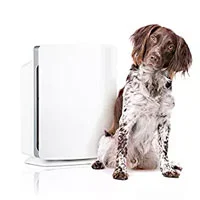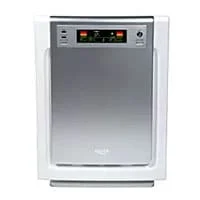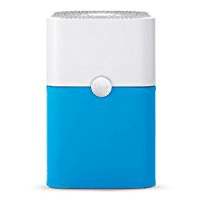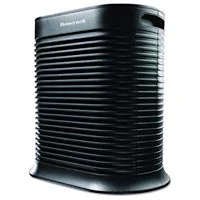Best Air Purifier for Cat Allergies
Quick Guide
- Can an air purifier help with cat allergies?
- A good air purifier is a powerful part of a complete allergy control program.
- What is the Best Air Purifier for Cat Allergies?
- Types of Air Purifiers
- Finding a Great Air Purifier for Cat Allergies: What to Look For
- Top 5 Recommended Air Purifiers for Cat Allergies
- Alen BreatheSmart Classic Customizable Air Purifier Fur Family Bundle with HEPA Filter Review
- Rabbit Air BioGS 2.0 Ultra Quiet HEPA Air Purifier Review
- Blue Pure 211+ Air Purifier with Particle and Carbon Filter for Allergen and Odor Reduction Review
- Winix HR900, Ultimate Pet 5 Stage True HEPA Filtration Air Purifier Review
- Honeywell HPA200 True HEPA Allergen Remover, 310 sq. ft Review
Can an air purifier help with cat allergies?
The United States Environmental Protection Agency (EPA) and the American Lung Association agree that air filtration is a good choice for individuals suffering from allergies and asthma, but an air purifier shouldn’t be the only weapon in your anti-allergy arsenal.
A good air purifier is a powerful part of a complete allergy control program.
Remember, an air purifier is only one part of a multi-tiered allergy control system. Here are some tips to help you to manage cat dander and reduce allergy symptoms.
Choose the right vacuum and clean the floors regularly.
Cat dander can stick to carpets, rugs, and upholstery. Regular vacuuming with the appropriate cleaner can help to minimize your exposure. Select a vacuum with a HEPA filter and well-contained dirt collection area.
Another way to minimize your exposure to dander is by avoiding carpeted floors, which retain fur and dander.
What is the Best Air Purifier for Cat Allergies?
- Alen BreatheSmart Classic Customizable Air Purifier for Pet Dander/Odor with HEPA Filter
- Rabbit Air BioGS 2.0 Ultra Quiet HEPA Air Purifier
- Blue Pure 211+ Air Purifier with Particle and Carbon Filter for Allergen and Odor Reduction
- Winix HR900, Ultimate Pet 5 Stage True HEPA Filtration Air Purifier
- Honeywell HPA200 True HEPA Allergen Remover, 310 sq. f
Create a cat-free space.
Because the bedroom is probably the part of your house in which you spend the most time, it’s a good idea for allergy sufferers to prohibit their cats from entering that room. If you can put an air purifier in only one room, choose the bedroom.
Bathe your cat.
Bathing is an effective way to remove dander buildup and saliva on your cat’s body. Using only non-toxic cat shampoo, bathe your cat every four to six weeks.
Once you’ve implemented all of these anti-allergy tactics, consider an air purifier as a final line of defense against airborne allergens from your cat.
Types of Air Purifiers
There are two fundamental types of air purifiers: active purifiers and passive purifiers.
Active Purifiers
Active purifiers use a variety of methods to sanitize the air by killing airborne bacteria, viruses, germs, and spores. They’re not as effective for capturing allergens.
Ionizers
These purifiers release ions. The ions may be negative, positive, or both, and they work by bonding to molecules in the air and destroying them. They’ve been criticized for their propensity to generate ozone, which is considered an air pollutant and could have serious negative health effects.
Ozone Generators
Ozone is a powerful natural air sanitizer with the ability to eliminate odors and destroy airborne bacteria, viruses, and mold. Unfortunately, an amount of ozone capable of sanitizing the air is also capable of doing harm when inhaled.
UV Sanitizers
UV lamps can destroy microbial particles including mold spores, bacteria, and viruses. While they’re an effective choice for destroying microbes, only a good filter can capture allergens.
Passive Purifiers
Passive purifiers capture rather than destroy particles. They have a filtration system that prevents particles from continuing to spread through the air. This is the type that will help most with cat allergies.
Homemade Air Purifiers
Air purifiers are available at a wide range of prices. Cheaper models found at big box stores might cost as little as $50, while heavy-duty units may set you back $1000 or more.
A homemade air filter is a low-cost alternative to commercially available units. This video shows you how to assemble a simple homemade air filter using a air conditioner HEPA filter and a standard box fan.
Finding a Great Air Purifier for Cat Allergies: What to Look For
Advanced Filtration
If you’re overwhelmed, ignore all of the other features found in air purifiers and pay attention to a single fundamental component: the filtration system. It’s the key to the purifier’s ability to control airborne allergens.
HEPA Filtration
Look for air purifiers built with a true HEPA filter (high efficiency particulate air filter). HEPA filters capture 99.97% of particles at a size of .3 microns and above. Because of their exceptional ability to arrest airborne particulates, these filters are used to purify the air in medical facilities and cleanrooms. Perhaps most famously, these filters were used in the Manhattan Project to stop the spread of airborne radioactive contaminants.
Some air purifiers feature a filtration system with a “HEPA style filter, “HEPA-like filter”, or “HEPA-type” filter. These filters don’t satisfy the official requirements for a true HEPA filter and may not meet performance standards.
These filters are rated based on how well they block particles of varied sizes. They’re rated according to the “minimum efficiency reporting system” or MERV. HEPA filters are available in a range of MERV ratings from MERV 1 to MERV 12. Higher MERV ratings equate to the ability to remove smaller particles. Filters rated at a MERV 10 or higher are best for arresting allergens.
Unfortunately, most air purifiers don’t publicize the MERV rating of the HEPA filter. You’ll need to largely rely on reviews to make a guess about the effectiveness of the HEPA filter. The quality of the air purifier’s construction also plays a part in how well the HEPA filter captures allergens.
Pre-filters
Pre-filters are more porous than the main particle filter. This allows them to capture large particles and prevent them from entering the HEPA filter. A prefilter helps to increase the filtration system’s longevity.
Carbon Filtration
Activated carbon captures chemical vapors in the air, helping to rid the atmosphere of odors. If you’re often bothered by litter box smells, a carbon filter can help to neutralize them, along with other household odors.
Electrostatic Filtration
Some filters use electrical charges to attract small, light particles in the air. These typically aren’t as effective at capturing allergens, so it’s usually better to use a traditional HEPA filter.
Minimal Ozone Production
Ionizing purifiers, along with dedicated ozone generators, produce ozone.
Ozone is considered an air pollutant by the United States EPA and other government organizations. Breathing it is associated with impaired lung function, chest pain, coughing, and a diminished ability to fight respiratory illness.
Low Operating Costs
Look for an air purifier that has been Energy Star Approved – these are certified energy efficient and will help you to save on the electric bill. Replacement filters also add to the yearly cost of owning an air purifier. Filters range in price, with the highest costing over $100. One way to minimize your operating costs is to choose a unit with a washable pre-filter that can capture large particles before they enter the HEPA filter.
Minimal Noise
Some air purifiers are loud enough to compete with conversation and relaxation.Look for quiet units with multiple speed settings, allowing you to turn down the volume when you need a quiet space.
Fast and Effective Purification
To control cat allergens, an air purifier should clean an entire room at least six times per hour. Some units tell you how many times they will clean a specific room size per hour. You can also calculate this based on the purifier’s CADR and the size of your room.
The CADR, or clean air delivery rate, is one measure of an air purifier’s ability to effectively eliminate airborne particles. The clean air delivery rate is the number of cubic feet of air the unit will purify per minute.
Some air purifiers have CADR certification granted by the Association of Home Appliance Manufacturers. To attain this certification, manufacturers must subject their air purifier to specific testing procedures that determine the filtering speed and ability to filter dust, tobacco smoke, and pollen.
Top 5 Recommended Air Purifiers for Cat Allergies
Alen BreatheSmart Classic Customizable Air Purifier Fur Family Bundle with HEPA Filter Review

Air first moves through a washable pre-filter, which captures large airborne materials like cat hair, dust, and other particles before they can clog the HEPA filter.
HEPA-OdorCell technology promises to neutralize pet odors. This activated carbon filter helps to reduce odors and chemicals in the air.
The primary particle filter is a true HEPA filter.
Unlike some air purifiers that emit a loud operating noise, this machine generates “pink noise”, which the company describes as soothing, stating that it helps to cover disrupting sounds. Most customer reviews corroborate these claims, saying that it’s a quiet purifier that you can comfortably run in the room during sleep.
This unit from Alen features a SmartSensor, which automatically analyzes air quality and automatically switches between the four speed settings.
The purifier is designed to cover up to 1,100 square feet in an open concept room. – Buy It
Pros
- Energy Star Energy Efficient Certified
- Generates pink noise for little or no sleep disruption
- Available in a wide range of color shades to suit almost any decor scheme
- Comes with a limited lifetime warranty
Cons
- Priced at over $600, this air purifier is on the expensive end of the spectrum
Rabbit Air BioGS 2.0 Ultra Quiet HEPA Air Purifier Review
An affordable option at around $400, the Rabbit Air hits the sweet spot where price and quality collide.
It can clean 625 square feet twice an hour on it’s highest setting and is backed by a 5 year warranty.
Outside of it’s silent ability to freshen and filter the air it has won design awards from multiple well known product design competitions. Which means it’s great at cleaning and it looks good doing it.
In addition to it’s aesthetic appeal the Rabbit air is Energy Star certified so your electric bill won’t take a hit.
For those of you looking to get technical it offers a BioGS HEPA Filtration that has 4 stages of deodorization and purification. The charcoal based filters last around 3 years if used during waking hours. – Buy It
Pros
- Nearly silent on low settings
- Cleans up to 625 sq. feet
- 4 Level Filtration
- Isn’t an eyesore
- 5 Year Warranty
Cons
-
- Customers complain that the status lights on the unit are too bright during sleeping hours
Blue Pure 211+ Air Purifier with Particle and Carbon Filter for Allergen and Odor Reduction Review
The filter is not a true HEPA filter. Blueair’s own testing indicates that the filter captures 99.97% of PM 2.5, but fails to meet the HEPA requirements for capturing smoke. While this might be a dealbreaker for some other purifiers, this unit appears to perform excellently.
The three-level filtration system includes a fabric pre-filter for capturing large particles like cat hair, a particle filter that catches allergens, mold, and other irritants, plus a carbon filter for neutralizing odors. Compared to some other carbon filters, this one is on the light side and isn’t exceptionally effective for odor removal.
The fabric pre-filters come in multiple colors, allowing you to customize the appearance of the purifier to suit your decor scheme.
The filters cost about $60 and need to be replaced about once every six months.
It’s quiet and Energy Star rated for best in class energy efficiency. Switching between the three fan speed modes is simple with one-button control.
It does have an operating light that doesn’t turn off during use. Some people find this light disturbing during sleep.
The air purifier is AHAM rated at 540 square feet and is best suited for medium and large rooms between 500 and 600 feet. It cleans air in these rooms five times per hour.
All Blue Pure units come with a 1 year warranty. Once registered, this unit will be covered by a 2 year warranty. – Buy It
Pros
- Chic, modern design with multiple color options
- Simple one-button operation
- Energy Star Certified for energy efficiency
- Quiet and unobtrusive
Cons
- Some reviewers state that the purifier creates a bad smell
- Doesn’t have a true HEPA filter
- Doesn’t have any handles, making it difficult to move from room to room
Winix HR900, Ultimate Pet 5 Stage True HEPA Filtration Air Purifier Review

This unit from Winix offers five-stage air cleaning, which eliminates allergens, dust, viruses, and helps to reduce odors. Air first passes through the washable pre-filter, which captures cat hair, dust, and other larger airborne particles that could clog the HEPA filter. The main filter is a true HEPA filter, removing 99.97% of all particulate matter at .3 microns. CleanCel anti-bacterial treatment attempts to scrub bacteria from the air. The final filtration stage is odor elimination, achieved by an activated carbon filter.
The unit features Winix PlasmaWave Technology, which is an ionizer that breaks down pollutants on a molecular level. The PlasmaWave Technology releases negative and positive ions into the air. These break down pollutants on a molecular level.
This process generates trace amounts of ozone. According to a representative of the company, the PlasmaWave generates less than 10ppb (parts per billion), which is well below the 50ppb considered a health risk to sensitive groups.
The purifier is AHAM certified and recommended for cleaning a 283 square foot room. It has four operating speeds and can switch between low, medium, high, and turbo mode. The automatic setting allows the purifier to automatically adjust to the air quality in the home.
The lowest setting is quiet, while the other ones create more noise.
The on-screen display indicates the amount of contaminants in the room. An auto dim feature allows the unit to detect the amount of light in the room and dims accordingly. This model displays an LED alert when it’s time to change the filter. The filters cost about $90. – Buy It
Pros
- Features a true HEPA filter for capturing allergens
- At just over $200, this is a low to mid-cost air purifier
- The unit can be controlled via the control panel or using a remote control
- Features an informative display
- Quiet and unobtrusive
- Energy Star certified for energy efficiency
Cons
- Not the most visually appealing unit
- The replacement filters are expensive
Honeywell HPA200 True HEPA Allergen Remover, 310 sq. ft Review

According to customer reviews, the purifier is typically quiet except when on turbo mode. It has an automatic shut off timer that you can set for two, four, and eight hour intervals.
This unit features an activated carbon pre-filter that traps both odors and larger particles. The carbon filter isn’t particularly strong, so it’s not recommended for those who want to eliminate all odors with their purifier.
Behind the pre-filter is a true HEPA filter. The company recommends that this filter is replaced every three months, although others say that it will last about a year.
The purifier is AHAM verified for rooms of 155 square feet. Its CADR is 200 for tobacco smoke, 190 for dust, and 180 for pollen. It’s best suited for small rooms, in which it will clean the air five times per hour.
Overall, it’s a straightforward, effective air purifier for a low price. – Buy It
Pros
- Energy Star qualified
- Small and stylish
- An affordable model at under $200
- The number one brand recommended by allergists
- Honeywell offers a 5 year limited warranty
Cons
- Some customers have complained that it omits a chemical smell
















